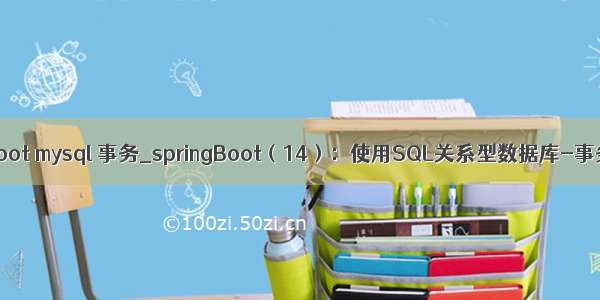
前两章节主要讲解了在SpringBoot中关于对数据的操作,本章节将介绍如何进行事务处理。所有的数据访问技术都离不开事务处理,否则将会造成数据不一致。事务是一系列的动作,一旦其中有一个动作出现错误,必须全部回滚,系统将事务中对数据库的所有已完成的操作全部撤消,滚回到事务开始的状态,避免出现由于数据不一致而导致的接下来一系列的错误。事务的出现是为了确保数据的完整性和一致性,在目前企业级应用开发中,事务管理是必不可少的。
1、SpringBoot事务机制
事务处理机制都会提供API来开启事务、提交事务来完成数据操作,或者在发生错误的时候回滚数据,避免数据的不完整性、不一致性。
SpringBoot事务机制实质上就是Spring的事务机制,是采用统一的机制处理来自不同数据访问技术的事务处理,提供了一个接口PlatformTransactionManager,已经为不同数据访问技术可以进行不同的实现,如下表。
涉及到接口关系如下:
接口PlatformTransactionManager源码如下:
/** Copyright 2002- the original author or authors.** Licensed under the Apache License, Version 2.0 (the "License");* you may not use this file except in compliance with the License.* You may obtain a copy of the License at**/licenses/LICENSE-2.0** Unless required by applicable law or agreed to in writing, software* distributed under the License is distributed on an "AS IS" BASIS,* WITHOUT WARRANTIES OR CONDITIONS OF ANY KIND, either express or implied.* See the License for the specific language governing permissions and* limitations under the License.*/package org.springframework.transaction;import org.springframework.lang.Nullable;/*** This is the central interface in Spring's transaction infrastructure.* Applications can use this directly, but it is not primarily meant as API:* Typically, applications will work with either TransactionTemplate or* declarative transaction demarcation through AOP.** <p>For implementors, it is recommended to derive from the provided* {@link org.springframework.transaction.support.AbstractPlatformTransactionManager}* class, which pre-implements the defined propagation behavior and takes care* of transaction synchronization handling. Subclasses have to implement* template methods for specific states of the underlying transaction,* for example: begin, suspend, resume, commit.** <p>The default implementations of this strategy interface are* {@link org.springframework.transaction.jta.JtaTransactionManager} and* {@link org.springframework.jdbc.datasource.DataSourceTransactionManager},* which can serve as an implementation guide for other transaction strategies.** @author Rod Johnson* @author Juergen Hoeller* @since 16.05.* @see org.springframework.transaction.support.TransactionTemplate* @see org.springframework.transaction.interceptor.TransactionInterceptor* @see org.springframework.transaction.interceptor.TransactionProxyFactoryBean*/public interface PlatformTransactionManager {/*** Return a currently active transaction or create a new one, according to* the specified propagation behavior.* <p>Note that parameters like isolation level or timeout will only be applied* to new transactions, and thus be ignored when participating in active ones.* <p>Furthermore, not all transaction definition settings will be supported* by every transaction manager: A proper transaction manager implementation* should throw an exception when unsupported settings are encountered.* <p>An exception to the above rule is the read-only flag, which should be* ignored if no explicit read-only mode is supported. Essentially, the* read-only flag is just a hint for potential optimization.* @param definition TransactionDefinition instance (can be {@code null} for defaults),* describing propagation behavior, isolation level, timeout etc.* @return transaction status object representing the new or current transaction* @throws TransactionException in case of lookup, creation, or system errors* @throws IllegalTransactionStateException if the given transaction definition* cannot be executed (for example, if a currently active transaction is in* conflict with the specified propagation behavior)* @see TransactionDefinition#getPropagationBehavior* @see TransactionDefinition#getIsolationLevel* @see TransactionDefinition#getTimeout* @see TransactionDefinition#isReadOnly*/TransactionStatus getTransaction(@Nullable TransactionDefinition definition) throws TransactionException;/*** Commit the given transaction, with regard to its status. If the transaction* has been marked rollback-only programmatically, perform a rollback.* <p>If the transaction wasn't a new one, omit the commit for proper* participation in the surrounding transaction. If a previous transaction* has been suspended to be able to create a new one, resume the previous* transaction after committing the new one.* <p>Note that when the commit call completes, no matter if normally or* throwing an exception, the transaction must be fully completed and* cleaned up. No rollback call should be expected in such a case.* <p>If this method throws an exception other than a TransactionException,* then some before-commit error caused the commit attempt to fail. For* example, an O/R Mapping tool might have tried to flush changes to the* database right before commit, with the resulting DataAccessException* causing the transaction to fail. The original exception will be* propagated to the caller of this commit method in such a case.* @param status object returned by the {@code getTransaction} method* @throws UnexpectedRollbackException in case of an unexpected rollback* that the transaction coordinator initiated* @throws HeuristicCompletionException in case of a transaction failure* caused by a heuristic decision on the side of the transaction coordinator* @throws TransactionSystemException in case of commit or system errors* (typically caused by fundamental resource failures)* @throws IllegalTransactionStateException if the given transaction* is already completed (that is, committed or rolled back)* @see TransactionStatus#setRollbackOnly*/void commit(TransactionStatus status) throws TransactionException;/*** Perform a rollback of the given transaction.* <p>If the transaction wasn't a new one, just set it rollback-only for proper* participation in the surrounding transaction. If a previous transaction* has been suspended to be able to create a new one, resume the previous* transaction after rolling back the new one.* <p><b>Do not call rollback on a transaction if commit threw an exception.</b>* The transaction will already have been completed and cleaned up when commit* returns, even in case of a commit exception. Consequently, a rollback call* after commit failure will lead to an IllegalTransactionStateException.* @param status object returned by the {@code getTransaction} method* @throws TransactionSystemException in case of rollback or system errors* (typically caused by fundamental resource failures)* @throws IllegalTransactionStateException if the given transaction* is already completed (that is, committed or rolled back)*/void rollback(TransactionStatus status) throws TransactionException;}
2、声明式事务
建立在AOP之上的,其本质是对方法前后进行拦截,然后在目标方法开始之前创建或者加入一个事务,在执行完目标方法之后根据执行情况提交或者回滚事务。声明式事务最大的优点就是不需要通过编程的方式管理事务,这样就不需要在业务逻辑代码中掺杂事务管理的代码,只需在配置文件中做相关的事务规则声明(或通过基于@Transactional注解的方式),便可以将事务规则应用到业务逻辑中。
Spring支持声明式事务,被注解的方法在被调用时,Spring开启一个新的事务,当方法无异常结束后,Spring会提交这个事务。
@Transactionalpublic void insertUser(User user) {//数据库表的操作……}
注:
(1)@Transactional是来自org.springframework.transaction.annotation包的。
(2)@Transactional不仅可以注解在方法上,也可以注解在类上。当注解在类上时,意味着此类的所有public方法都是开启事务的。如果类级别和方法级别同时使用了@Transactional注解,则使用在类级别的注解会重载方法级别的注解。
以下为注解@Transactional源码:
(为了缩小所占篇数,故去掉注释部分)
package org.springframework.transaction.annotation;import java.lang.annotation.Documented;import java.lang.annotation.ElementType;import java.lang.annotation.Inherited;import java.lang.annotation.Retention;import java.lang.annotation.RetentionPolicy;import java.lang.annotation.Target;import org.springframework.core.annotation.AliasFor;import org.springframework.transaction.TransactionDefinition;@Target({ElementType.METHOD, ElementType.TYPE})@Retention(RetentionPolicy.RUNTIME)@Inherited@Documentedpublic @interface Transactional {@AliasFor("transactionManager")String value() default "";@AliasFor("value")String transactionManager() default "";Propagation propagation() default Propagation.REQUIRED;Isolation isolation() default Isolation.DEFAULT;int timeout() default TransactionDefinition.TIMEOUT_DEFAULT;boolean readOnly() default false;Class<? extends Throwable>[] rollbackFor() default {};String[] rollbackForClassName() default {};Class<? extends Throwable>[] noRollbackFor() default {};String[] noRollbackForClassName() default {};}
属性说明如下表:
在SpringBoot中,建议采用注解@Transactional进行事务的控制。
欢迎微信扫码下面二维码,进行更多交流学习!
















